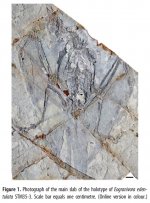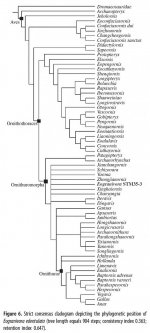Fred Ruhe
Well-known member

Xiaoting Zheng, Jingmai K. O'Connor, Xiaoli Wang, Yan Wang, Zhonghe Zhou, 2018
Reinterpretation of a previously described Jehol bird clarifies early trophic evolution in the Ornithuromorpha
Proceedings of the Royal Society B: Biological Sciences. 285 (1871): 20172494. doi:10.1098/rspb.2017.2494
Abstract:
STM35-3 from the Yixian Formation is the only Early Cretaceous ornithuromorph preserving direct evidence of granivory. The crop contains numerous seeds and the preservation of gastroliths presumably within the ventriculus indicates this diet was paired with the presence of a gastric mill as in living granivorous birds. STM35-3 was originally referred to Hongshanornis longicresta, member of a diverse clade of small, basal ornithuromorphs with elongate hindlimbs known as the Hongshanornithidae. Hindlimb proportions suggest that hongshanornithids were wading birds, an ecological inference somewhat in conflict with direct evidence suggesting Hongshanornis fed on seeds. However, close inspection of STM35-3 reveals that the specimen represents a new species not closely related to hongshanornithids, distinguished by large forelimbs that exceed the length of the hindlimbs, robust and narrow coracoids, and a delicate edentulous rostrum. By contrast, all hongshanornithids have hindlimbs that far exceed the length of the forelimbs, coracoids with wide sternal margins, and small teeth throughout the upper and lower jaws. Reinterpretation of this new taxon, Eogranivora edentulata gen. et sp. nov, helps to clarify trophic driven patterns of tooth loss within the Ornithuromorpha. Apparent loss of the hallux may represent the first such occurrence in a Mesozoic bird and suggests a highly terrestrial lifestyle.
Enjoy,
Fred
Reinterpretation of a previously described Jehol bird clarifies early trophic evolution in the Ornithuromorpha
Proceedings of the Royal Society B: Biological Sciences. 285 (1871): 20172494. doi:10.1098/rspb.2017.2494
Abstract:
STM35-3 from the Yixian Formation is the only Early Cretaceous ornithuromorph preserving direct evidence of granivory. The crop contains numerous seeds and the preservation of gastroliths presumably within the ventriculus indicates this diet was paired with the presence of a gastric mill as in living granivorous birds. STM35-3 was originally referred to Hongshanornis longicresta, member of a diverse clade of small, basal ornithuromorphs with elongate hindlimbs known as the Hongshanornithidae. Hindlimb proportions suggest that hongshanornithids were wading birds, an ecological inference somewhat in conflict with direct evidence suggesting Hongshanornis fed on seeds. However, close inspection of STM35-3 reveals that the specimen represents a new species not closely related to hongshanornithids, distinguished by large forelimbs that exceed the length of the hindlimbs, robust and narrow coracoids, and a delicate edentulous rostrum. By contrast, all hongshanornithids have hindlimbs that far exceed the length of the forelimbs, coracoids with wide sternal margins, and small teeth throughout the upper and lower jaws. Reinterpretation of this new taxon, Eogranivora edentulata gen. et sp. nov, helps to clarify trophic driven patterns of tooth loss within the Ornithuromorpha. Apparent loss of the hallux may represent the first such occurrence in a Mesozoic bird and suggests a highly terrestrial lifestyle.
Enjoy,
Fred





